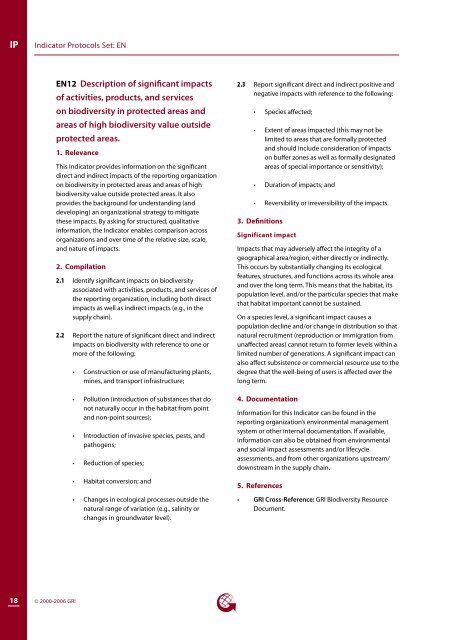Environment - Global Reporting Initiative
Environment - Global Reporting Initiative
Environment - Global Reporting Initiative
You also want an ePaper? Increase the reach of your titles
YUMPU automatically turns print PDFs into web optimized ePapers that Google loves.
IP<br />
Indicator Protocols Set: EN<br />
EN12 Description of significant impacts<br />
of activities, products, and services<br />
on biodiversity in protected areas and<br />
areas of high biodiversity value outside<br />
protected areas.<br />
1. Relevance<br />
This Indicator provides information on the significant<br />
direct and indirect impacts of the reporting organization<br />
on biodiversity in protected areas and areas of high<br />
biodiversity value outside protected areas. It also<br />
provides the background for understanding (and<br />
developing) an organizational strategy to mitigate<br />
these impacts. By asking for structured, qualitative<br />
information, the Indicator enables comparison across<br />
organizations and over time of the relative size, scale,<br />
and nature of impacts.<br />
2. Compilation<br />
2.1 Identify significant impacts on biodiversity<br />
associated with activities, products, and services of<br />
the reporting organization, including both direct<br />
impacts as well as indirect impacts (e.g., in the<br />
supply chain).<br />
2.2 Report the nature of significant direct and indirect<br />
impacts on biodiversity with reference to one or<br />
more of the following:<br />
• Construction or use of manufacturing plants,<br />
mines, and transport infrastructure;<br />
• Pollution (introduction of substances that do<br />
not naturally occur in the habitat from point<br />
and non-point sources);<br />
• Introduction of invasive species, pests, and<br />
pathogens;<br />
• Reduction of species;<br />
• Habitat conversion; and<br />
• Changes in ecological processes outside the<br />
natural range of variation (e.g., salinity or<br />
changes in groundwater level).<br />
2.3 Report significant direct and indirect positive and<br />
negative impacts with reference to the following:<br />
• Species affected;<br />
• Extent of areas impacted (this may not be<br />
limited to areas that are formally protected<br />
and should include consideration of impacts<br />
on buffer zones as well as formally designated<br />
areas of special importance or sensitivity);<br />
• Duration of impacts; and<br />
• Reversibility or irreversibility of the impacts.<br />
3. Definitions<br />
Significant impact<br />
Impacts that may adversely affect the integrity of a<br />
geographical area/region, either directly or indirectly.<br />
This occurs by substantially changing its ecological<br />
features, structures, and functions across its whole area<br />
and over the long term. This means that the habitat, its<br />
population level, and/or the particular species that make<br />
that habitat important cannot be sustained.<br />
On a species level, a significant impact causes a<br />
population decline and/or change in distribution so that<br />
natural recruitment (reproduction or immigration from<br />
unaffected areas) cannot return to former levels within a<br />
limited number of generations. A significant impact can<br />
also affect subsistence or commercial resource use to the<br />
degree that the well-being of users is affected over the<br />
long term.<br />
4. Documentation<br />
Information for this Indicator can be found in the<br />
reporting organization’s environmental management<br />
system or other internal documentation. If available,<br />
information can also be obtained from environmental<br />
and social impact assessments and/or lifecycle<br />
assessments, and from other organizations upstream/<br />
downstream in the supply chain.<br />
5. References<br />
• GRI Cross-Reference: GRI Biodiversity Resource<br />
Document.<br />
18<br />
© 2000-2006 GRI

















